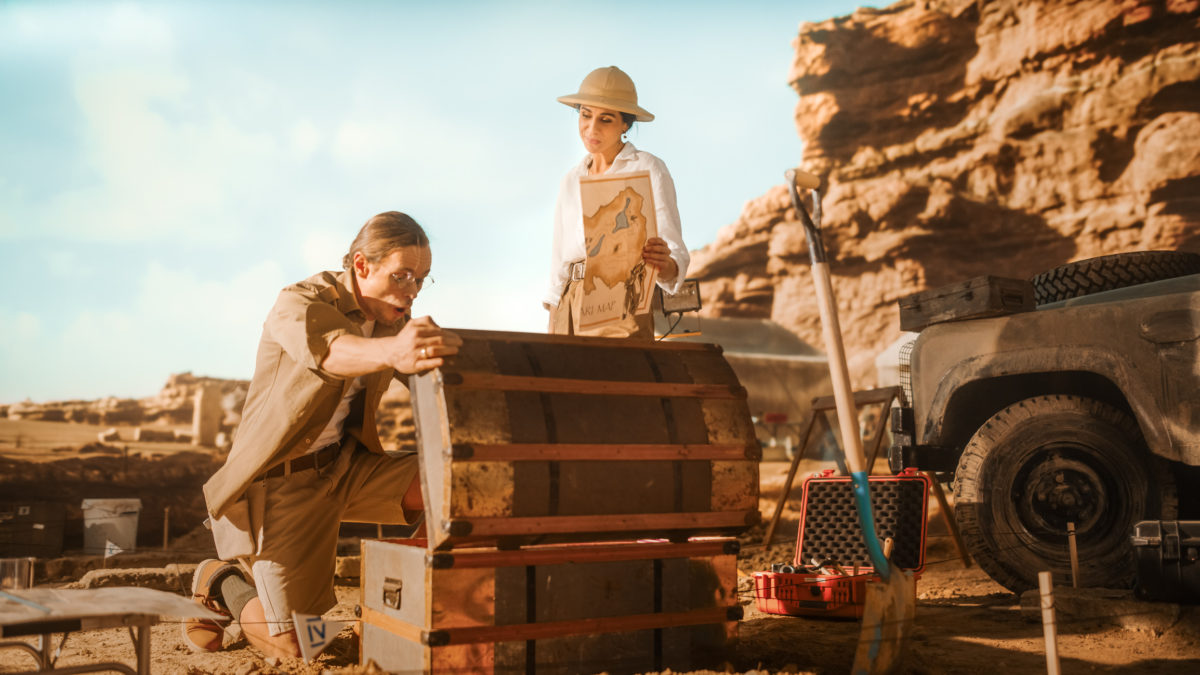Back to the Future: This nickel explorer sees gold in Kambalda’s forgotten treasures

Pic: gorodenkoff/iStock via Getty Images
- Lunnon Metals is aiming to revive Kambalda’s first nickel mine, the Silver Lake discovery
- The explorer controls 2sqkm of undrilled ground between the famous region’s 2nd and 3rd most prolific deposits
- Advocates for brownfields exploration often say the best place to find a mine is under an old one
If you’ve spent any time looking at junior mining stocks you’d be familiar with the theory that the best place to find a gold mine, or any other kind of metals deposit for that matter, is underneath an old one.
Known as brownfields exploration — as opposed to greenfields, the process of exploring for entirely new orebodies — the strategy has worked out stunningly well for any number of miners.
This is not always true. The likelihood of finding something massive like De Grey Mining’s (ASX:DEG) Hemi gold discovery or Chalice Mining’s (ASX:CHN) Julimar nickel and PGE deposit is low on ground that is already well-trodden.
But there are many reasons, like logistics, technology, capital allocation and low metal prices that explain why some very good prospects have gone undiscovered even though they have been right under the nose of a global major.
One of the poster children for that concept is ASX 50 gold miner Northern Star Resources (ASX:NST), which is currently investing $125 million a year in exploration mainly around mines which are already producing and have done so for decades, including Kalgoorlie’s famous Super Pit and Golden Mile.
Another is Mincor Resources (ASX:MCR), which recently restarted nickel mining in Kambalda, where it owns most of the ground once held by Western Mining Corporation before it began to sell off the Kambalda assets that made it famous at the turn of the century.
Most but not all
There are other companies kicking around the Kambalda Dome, home to over 1.5Mt of historic nickel metal production.
Private equity backed Black Mountain Metals boasts the Lanfranchi project, once in the hands of both WMC and Panoramic Resources (ASX:PAN).
Then there is Lunnon Metals (ASX:LM8), a company with the history of Kambalda etched into its fabric.
Lunnon listed on the ASX last year after acquiring the historic and forgotten Foster and Jan nickel mines from South African gold miner and major shareholder Gold Fields last year.
It has since proven the old dog did have some new tricks, making the Baker discovery, where a maiden resource included 568,000t at 2.8% Ni for 15,800t.
In total its resources have grown 65% to 2.2Mt at 2.9% nickel for 64,300t since the IPO.
But a new acquisition from Lunnon, expanding its Kambalda portfolio, has seen it turn back the clock to the start of Australia’s first nickel boom.
Extending its relationship with Gold Fields, LM8 picked up the nickel rights at the Silver Lake and Fisher mines from the St Ives gold mine operator earlier this year.
Announced in April, the $20 million all share deal wrapped up after FIRB approval in October.
There is a genuine sense of romance to the purchase.
Silver Lake was Kambalda’s first nickel mine and its third largest producer, the shaft sunk where driller Jack Lunnon, under the direction of legendary WMC geologist Roy Woodall, punched the KD01 discovery hole at Kambalda on January 28, 1966.
More than romance
The ultimate brownfields nickel play, LM8 managing director Ed Ainscough says the decision to revisit Silver Lake is about far more than reliving Kambalda’s origin story.
The project, which produced 123,000t of nickel metal between 1966 and 1986, was a coveted asset for juniors operating in the region for years, dating back to Ainscough’s time leading the geology team at the St Ives gold project in the early 2000s.
“There’s a huge dollop of romance without a doubt, I think the narrative though is real and strong,” he said.
“We’ve got the southern half of the dome, and I know in my time Independence (Group) under Chris Bonwick were always chasing me, when I was at Gold Fields, to get this ground and get the rights to Fisher and Silver Lake.
“I left Gold Fields in 2008. But up until I left they were very insistent that they wanted to get on that ground.
“So it’s been a coveted asset and we’re both blessed to get it but obviously, a big chunk of the reason we got it is because we had been successful on the other assets that Gold Fields vended into us at the IPO.”
Lunnon has announced an exploration target of between 0.65Mt and 1.3Mt at Silver Lake grading 1.3% to 2.7% nickel, with 260km of historical core from it and Fisher on hand at the St Ives/Kambalda core farm to assist.
According to the company the hanging wall prospect at Silver Lake bears remarkable similarities to the East Cooee hanging wall that ultimately played host to Baker.
You’d be more surprised if there was nothing
It remains a shock after all these years prospects like Baker and the Golden Mile discovery made by Lunnon’s neighbour Mincor, which delivered a maiden resource of 22,600t Ni metal at 3.9% this year, went unidentified for decades under WMC’s ownership.
Ainscough says its ground at the recently acquired Silver Lake nickel rights includes a 2sqkm zone between Silver Lake and the region’s second largest historic mine, Long, without any drilling.
“People talk about Kambalda being kind of elephant country. Otter Juan, which is shut now, was 300,000 nickel tonnes or thereabouts, Long shaft was over 200,000 nickel tonnes and then the third biggest was Silver Lake on 123,000 and then after that it was Durkin on about 100,000,” Ainscough says.
“The other three are all in Mincor’s ground and we’ve got Silver Lake, but the gap between them, bizarrely, has no drilling between the south end of Long shaft and Silver Lake. There’s no drilling at all.”
Lunnon shares have risen ~61% year to date and almost 120% over the past 12 months on the back of its exploration success at Baker to a market cap of around $88 million.
Ainscough is hopeful of repeating the dose at Silver Lake.
“I say this and I don’t say it blithely or flippantly, but it would actually be odder or more weird, if there was nothing there than if there was something there,” he quipped.
“It would be harder to explain geologically why there was nothing in that two square kilometres than if there was actually something there. So I think from a geological risk point of view, it’s very low.
“The quantum of the question will be how much is there and where does it sit in the profile? Is it big enough and high grade enough to warrant reopening Silver Lake to access it?”
Different fish to fry
As to why WMC never searched the ground itself, Ainscough suggested blinkers from allocating capital to drill at its operating mines from underground was one reason.
He said geologists always knew there was nickel at prospects like the ‘Golden Mile’, but there was no corporate appetite at the time.
“It’s not a criticism in my mind of WMC that they missed Baker, or that they missed the Golden Mile, it’s more of a recognition that they just had different fish to fry and the hurdles for what was significant were different then than they are now,” Ainscough said.
“Baker as an example, make no bones if they drilled one of those holes like 23m at 6.8% they would have gone back.
“There’s no way they would have drilled that in the hanging wall and gone, oh actually there’s nothing on the contact, we’re not going to follow that up.
“They would have followed that up, they would have found Baker and they would have mined it.
“So there’s definitely a big chunk of serendipity involved when you’re drilling in and around WMC’s existing drilling or previous drilling.
“But we’ve kind of learned to see it as a vector, as a guide to where to drill as opposed to somewhere to be avoided because it’s already been drilled.”
Do all romance stories have a happy ending?
It is worth acknowledging there are plenty of cases of brownfields sites, even famous ones, where miners have gone back in and found the place tapped dry or slowly added incremental tonnes without any wow factor.
Ainscough acknowledges there are no guarantees, but says Lunnon is in a fantastic place to revive some of the old Kambalda Dome deposits.
They surround BHP’s Kambalda Nickel Concentrator, part of the Nickel West business the world’s biggest miner has placed at the centre of its plans to refocus on green, future facing metals, supplying nickel to electric vehicle and battery makers like Tesla and Toyota.
“I’m very confident with that exploration target that we put together and effectively … that is a Leapfrog 3D estimate that if there is any high grade that sits within it, that will definitely come into JORC 2012,” Ainscough said.
“And then if we make a discovery, I think the economics will be interesting to look at as to whether it all justifies reentering.
“Silver Lake will be flooded, because it sits under the lake. But Foster’s flooded, so we’re not facing anything different at Silver Lake than we already face at Foster.
“And if the thematic with nickel and electric vehicles is everything that people say … you don’t even need to build a plant, you’ve got no processing capital.
“The hurdles from being an explorer to a producer are actually relatively quite low … as opposed to a greenfield site.”
Lunnon Metals (ASX:LM8) share price today:
Related Topics
UNLOCK INSIGHTS
Discover the untold stories of emerging ASX stocks.
Daily news and expert analysis, it's free to subscribe.
By proceeding, you confirm you understand that we handle personal information in accordance with our Privacy Policy.








